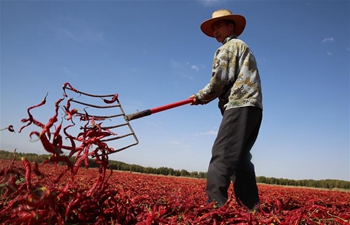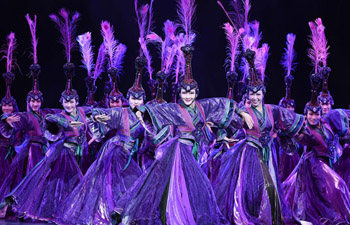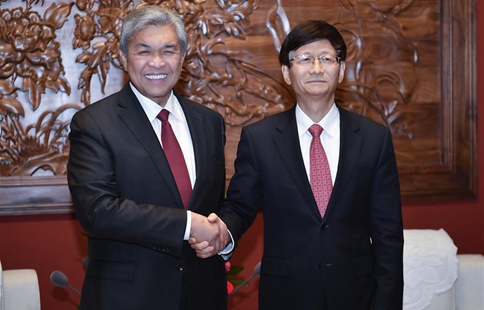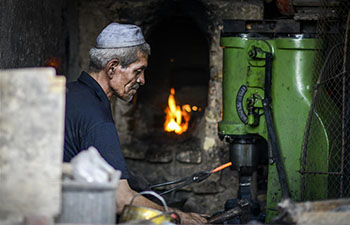WASHINGTON, Sept. 27 (Xinhua) -- Although traditional Chinese medicine as a whole is struggling in the United States, acupuncture itself is in a much better situation.
The ancient Chinese practice involving the insertion of fine needles into the skin was generally thought to be brought to America in the early 1970s, thanks to then-President Richard Nixon's ice-breaking visit to China.
About 45 years later, over 46 U.S. states have legalized acupuncture, and the number of licensed acupuncturists in the country has grown to around 45,000.
BIGGER ROLE
Now, local acupuncturists expressed hope that the ancient art of healing could play a bigger role in solving the ongoing U.S. opioid epidemic, which claims 91 American lives every single day.
"Acupuncture is an effective, safe, and cost-effective treatment for numerous types of acute and chronic pain," wrote a white paper released this week by several organizations that promote the practice in the United States.
"Acupuncture should be recommended as a first line treatment for pain before opiates are prescribed, and may reduce opioid use."
The white paper came about a week after the U.S. National Association of Attorneys General (NAAG) sent a letter to America's Health Insurance Plans (AHIP), asking its insurance company members to review their payment and coverage policies in order to promote alternatives to opioids, such as acupuncture.
Cathryn Donaldson, director of communications and public affairs for the AHIP, a trade association representing 1,300 health insurers, told Xinhua that they have responded to the NAAG letter, which was signed by 37 state and territorial attorneys general.
"Plans are exploring and improving access to non-pharmacologic pain treatments that have been proven effective in reducing pain," Donaldson said in an email.
"Depending on the individual patient, therapies like acupuncture, mind-body interventions (yoga), psychological interventions (cognitive therapy), and exercise can be an effective first line of treatment for many before moving on to pharmaceuticals when necessary," she said.
BIG DEAL
Although millions of Americans use acupuncture each year, the practice was considered primarily to be a complementary health approach.
As a result, many American acupuncturists were excited by the NAAG letter, which was virally spread and heatedly discussed in the social media. One of them, Fan Ying, whose clinic is based in the state of Virginia, called it "a big deal" for the industry.
"The spring of acupuncture might have come," said Fan, one of the authors of the white paper.
"The U.S. opioid crisis will allow non-pharmacologic therapies, including acupuncture, chiropractic care and medical massage, to have a place in the U.S. healthcare system," he said, but cautioned that "we can't say there will be no spring chill in the future."
Li Yongming, a licensed acupuncturist in the state of New Jersey, called the U.S. fight against opioid abuse and addiction "a new opium war."
"Acupuncture is the most effective in all kinds of non-pharmacologic therapies for pain relief and management," Li said.
"So the opioid crisis provides the best opportunity in decades for our industry to develop and even become more of a mainstream healthcare option. This may represent a new era of acupuncture."
Tian Haihe, president of the non-profit American TCM (traditional Chinese medicine) Association, noted that the NAAG letter is only a proposal, but it may indeed mean a turning point and that the next question could be how to grasp it.
"We must demonstrate to patients that we can help relieve their pain, so they will have no reason or excuse to use painkillers and thus avoid being addicted," Tian said.
"Even if the NAAG proposal is adopted, we should know that many private clinics that offer acupuncture treatments are still out of the insurance system, a problem we should worry about and think how to solve."
"If acupuncture is covered by health insurance eventually, it's way too good, but it should be a long process," Tian said. "We can't just wait. We need to provide scientific evidence to prove that acupuncture is safe and effective."
GENERALLY CONSIDERED SAFE
So, how does American academia think about the practice of acupuncture?
"Acupuncture is generally considered safe when performed by an experienced, well-trained practitioner using sterile needles. Improperly performed acupuncture can cause serious side effects," the U.S. National Center for Complementary and Integrative Health (NCCIH) wrote in an article posted on its website.
"Results from a number of studies suggest that acupuncture may help ease types of pain that are often chronic such as low-back pain, neck pain, and osteoarthritis/knee pain. It also may help reduce the frequency of tension headaches and prevent migraine headache," the NCCIH said.
What's more important, the U.S. Food and Drug Administration released a draft proposal in May recommending that doctors learn about acupuncture and other non-pharmacologic therapies for pain management.
Actually, a 2015 study conducted by Kaiser Permanente Center for Health Research, found that of more than 6,000 chronic pain patients who responded to a questionnaire, 32 percent reported acupuncture use, 47 percent reported chiropractic use and 21 percent reported using both.
The peer-reviewed work, published in the American Journal of Managed Care, included members of Kaiser Permanente health plan only.
"There is a growing body of scientific evidence which supports the use of acupuncture for pain management. Often the medications we use don't work well, or have too many side effects. Thus both doctors and patients are eager for alternatives," Charles Elder of the Kaiser Permanente Center for Health Research, the paper's first author, told Xinhua.
"It would make sense that the role of acupuncture should continue to grow in the context of managing chronic pain within our health care system," he said, citing as an example the state of Oregon where complementary medicine approaches including acupuncture are required to be covered for back pain patients of Medicaid -- a joint state-federal health care program.
"My guess is that we will see more of this in the future," Elder said.

















